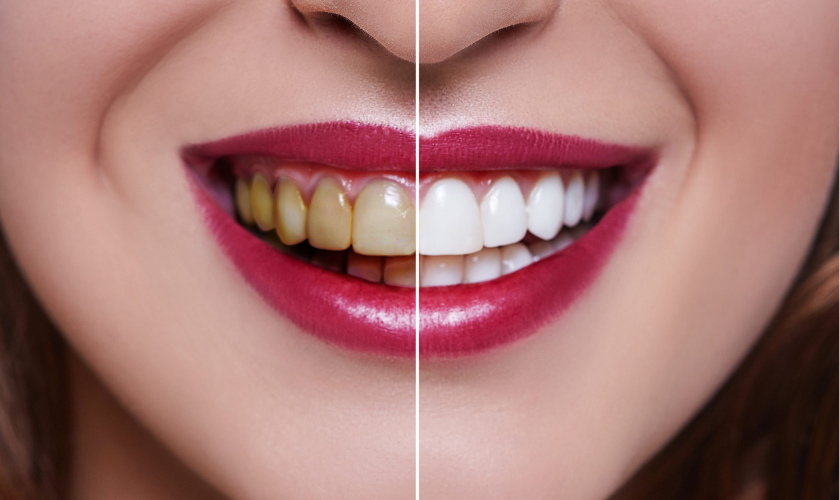The Ultimate Guide To Teeth Whitening

Before exploring teeth whitening options, it’s essential to understand why teeth become discolored in the first place. Teeth can stain or discolor due to various factors, including.
Extrinsic Stains
- These occur on the outer layer of the tooth (enamel) and are often caused by consuming dark-colored foods and beverages like coffee, tea, wine, and certain fruits, as well as smoking or poor oral hygiene practices.
Intrinsic Stains
- These occur within the tooth’s structure (dentin) and can be caused by factors such as aging, genetics, certain medications (e.g., tetracycline), or excessive fluoride exposure during tooth development.
Teeth Whitening Methods
There are several teeth whitening methods available, ranging from over-the-counter products to professional treatments performed by dentists. Here’s a breakdown of the most common options.
Over-The-Counter Whitening Products
Whitening Toothpaste
- Toothpaste containing abrasive particles or chemical agents like hydrogen peroxide can help remove surface stains. However, they may not be effective for deeper discoloration.
Whitening Strips and Gels
- These products typically contain hydrogen peroxide or carbamide peroxide and are applied directly to the teeth using strips or trays. They can be effective for mild to moderate staining but may take longer to achieve noticeable results.
Whitening Mouthwashes
- Mouthwashes containing whitening agents may help reduce surface stains and freshen breath but are generally less effective than other methods.
At-Home Whitening Kits
Custom Tray-Based Systems
- These kits involve custom-fitted trays filled with whitening gel, which the user wears over their teeth for a specified period, usually overnight or for a few hours daily. They offer more customized results compared to over-the-counter products.
LED Whitening Kits
- These kits include LED lights that are used in conjunction with whitening gel to accelerate the whitening process. While they may provide faster results, their effectiveness varies, and they may cause sensitivity in some individuals.
In-Office Professional Whitening
Chairside Whitening
- This procedure is performed by a dentist in-office and typically involves the application of a high-concentration bleaching agent to the teeth, activated by a light or laser. It can produce significant whitening results in a single session but may be more expensive than at-home options.
Take-Home Professional Kits
- Dentists may also provide custom-fitted trays and professional-strength whitening gel for patients to use at home. While it takes longer to see results compared to in-office treatments, it offers the convenience of at-home use with professional oversight.
What Works And What Doesn’t
Effective
- Professional whitening treatments, both in-office and take-home kits provided by dentists, are generally considered the most effective options for achieving noticeable and long-lasting results. These treatments utilize higher concentrations of whitening agents and are tailored to individual needs.
Moderately Effective
- At-home whitening kits, especially custom tray-based systems, can be effective for mild to moderate staining when used as directed over an extended period. They offer convenience and customization but may not produce results as quickly as professional treatments.
Less Effective
- Over-the-counter whitening products like toothpaste, strips, and gels can help reduce surface stains but may not be as effective for deeper discoloration or stubborn stains. Additionally, their results may vary, and they may not provide the level of whitening desired by some individuals.
Safety Considerations
While teeth whitening is generally considered safe when performed under professional guidance or using reputable products, there are some important safety considerations to keep in mind.
Tooth Sensitivity
- Whitening treatments can cause temporary tooth sensitivity, especially with higher concentrations of whitening agents. This sensitivity typically resolves after treatment but can be managed with desensitizing products or adjusting the treatment duration.
Gum Irritation
- Whitening agents can irritate the gums if they come into contact with them. Professional treatments minimize this risk by using protective barriers or applying whitening agents carefully.
Enamel Damage
- Overuse or misuse of whitening products can potentially damage tooth enamel, leading to increased sensitivity or other complications. It’s essential to follow instructions carefully and consult with a dentist if you have any concerns.
Maintaining Whitening Results
To prolong the results of teeth whitening treatments, it’s essential to practice good oral hygiene and minimize habits that can contribute to staining, such as smoking or consuming dark-colored foods and beverages. Additionally, regular dental check-ups and professional cleanings can help remove surface stains and maintain oral health.
Achieving a brighter, whiter smile is a common desire, and there are numerous teeth whitening options available to help you achieve your goals. From over-the-counter products to professional treatments, understanding what works and what doesn’t can help you make informed decisions about your oral care. Remember to prioritize safety, consult with a qualified dentist, and maintain good oral hygiene to enjoy a dazzling smile that boosts your confidence and enhances your overall well-being.
More to Read:
Previous Posts:
Next Posts:

